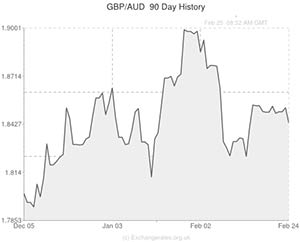
The Pound lost out on around a cent against both the Australian Dollar and the New Zealand Dollar yesterday as the Antipodeans rode on the crest of swelling risk sentiment.
The Sterling to Australian Dollar exchange rate (GBP/AUD) stooped from 1.8560 to 1.8440.
And the Pound to New Zealand exchange rate (GBP/NZD) tumbled from 2.0100 to 1.9990.
Sterling remained susceptible to
With UK CPI inflation falling to 1.9%, and thus below the Bank of England’s 2.0% target for the first time in four years; British Unemployment rising from 7.1% to 7.2% unexpectedly; Retail Sales tumbling by -1.5%, the steepest monthly decline since April 2012; and January’s budget surplus printing at £4.72 billion, which is around half the amount predicted by economists: the Pound found itself weakening against its major currency peers last week.
The ‘Aussie’ and the ‘Kiwi’ were able to take advantage of the slight drop-off in demand for Sterling as stocks rallied in Britain and in New York.
The FTSE 100 UK index of stocks closed at 6865, which is its highest level since 1999 and its second highest level ever.
The S&P 500 US stock index rose to an intraday record high of 1,858.71, before closing within 1 point of an all-time record closing high.
The sharp gains in equity markets were influenced, in part, by the progress in Ukraine. Following weeks of violent clashes between protestors and the state, Prime Minister Viktor Yanukovich was ousted from power over the weekend. The calm following Yanukovich’s impeachment has allayed fears that a civil war could break out.
Recent events could lead to a deal in the future to help Ukraine become more integrated with Western Europe; this was seen as a positive development and led to a moderate level of optimism around financial markets.
The most important data release for the Pound this week is hotting up to be Wednesday’s second estimate of fourth quarter GDP growth.
Analysts expect the second estimate to mirror the first with a reading of 0.7% – slightly lower than the 0.8% expansion registered in Q3 2013. Construction data from the fourth quarter was recently upgraded but it remains to be seen whether this positive revision will translate into a stronger Gross Domestic Product reading. Anything north of 0.7% could boost demand for Sterling; anything south could send the Pound spiraling lower against both the Australian Dollar and the New Zealand Dollar.

Comments are closed.